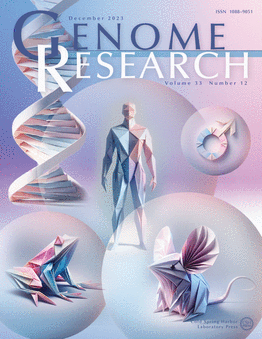UV damage and repair maps in Drosophila reveal the impact of domain-specific changes in nucleosome repeat length on repair efficiency
IF 6.2
2区 生物学
Q1 BIOCHEMISTRY & MOLECULAR BIOLOGY
引用次数: 0
Abstract
Cyclobutane pyrimidine dimers (CPDs) are formed in DNA following exposure to ultraviolet (UV) light and are mutagenic unless repaired by nucleotide excision repair (NER). It is known that CPD repair rates vary in different genome regions due to transcription-coupled NER and differences in chromatin accessibility; however, the impact of regional chromatin organization on CPD formation remains unclear. Furthermore, nucleosomes are known to modulate UV damage and repair activity, but how these damage and repair patterns are affected by the overarching chromatin domains in which these nucleosomes are located is not understood. Here, we generated a new CPD damage map in Drosophila S2 cells using CPD-seq and analyzed it alongside existing excision repair-sequencing (XR-seq) data to compare CPD damage formation and repair rates across five previously established chromatin types in Drosophila. This analysis revealed that repair activity varied substantially across different chromatin types, while CPD formation was relatively unaffected. Moreover, we observed distinct patterns of repair activity in nucleosomes located in different chromatin types, which we show is due to domain-specific differences in nucleosome repeat length (NRL). These findings indicate that NRL is altered in different chromatin types in Drosophila and that changes in NRL modulate the repair of UV lesions.果蝇的紫外线损伤和修复图谱揭示了核小体重复长度的区域特异性变化对修复效率的影响
环丁烷嘧啶二聚体(CPDs)在DNA暴露于紫外线(UV)光后形成,除非通过核苷酸切除修复(NER)修复,否则具有诱变性。众所周知,由于转录偶联NER和染色质可及性的差异,CPD修复率在不同的基因组区域有所不同;然而,区域染色质组织对CPD形成的影响尚不清楚。此外,已知核小体调节紫外线损伤和修复活性,但这些损伤和修复模式如何受到核小体所在的总体染色质结构域的影响尚不清楚。在这里,我们使用CPD-seq在果蝇S2细胞中生成了一个新的CPD损伤图,并将其与现有的切除修复测序(XR-seq)数据一起分析,以比较果蝇中五种先前建立的染色质类型的CPD损伤形成和修复率。该分析显示,修复活性在不同的染色质类型之间存在很大差异,而CPD的形成相对不受影响。此外,我们在不同染色质类型的核小体中观察到不同的修复活性模式,我们认为这是由于核小体重复长度(NRL)的区域特异性差异。这些发现表明,NRL在果蝇的不同染色质类型中发生改变,NRL的变化调节了紫外线损伤的修复。
本文章由计算机程序翻译,如有差异,请以英文原文为准。
求助全文
约1分钟内获得全文
求助全文
来源期刊

Genome research
生物-生化与分子生物学
CiteScore
12.40
自引率
1.40%
发文量
140
审稿时长
6 months
期刊介绍:
Launched in 1995, Genome Research is an international, continuously published, peer-reviewed journal that focuses on research that provides novel insights into the genome biology of all organisms, including advances in genomic medicine.
Among the topics considered by the journal are genome structure and function, comparative genomics, molecular evolution, genome-scale quantitative and population genetics, proteomics, epigenomics, and systems biology. The journal also features exciting gene discoveries and reports of cutting-edge computational biology and high-throughput methodologies.
New data in these areas are published as research papers, or methods and resource reports that provide novel information on technologies or tools that will be of interest to a broad readership. Complete data sets are presented electronically on the journal''s web site where appropriate. The journal also provides Reviews, Perspectives, and Insight/Outlook articles, which present commentary on the latest advances published both here and elsewhere, placing such progress in its broader biological context.
 求助内容:
求助内容: 应助结果提醒方式:
应助结果提醒方式:


